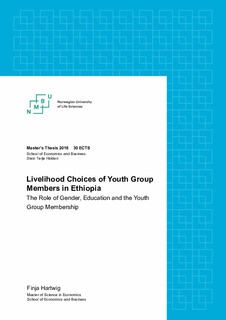| dc.description.abstract | In the Tigray region in Ethiopia, a promising program was launched to create livelihood opportunities for rural, landless youth: Youth are organized in groups, which are equipped with some land to carry out specific income generating activities (e.g. beekeeping) in a sustainable way. Hence, a possible win-win-win situation is created. But what role do the youth group activities play in their members’ livelihoods? In this study, a multinomial logit model and an ordered logit model were used to examine the occupational choice as well as the diversification strategies of 1,072 youth group members. Most of the youth receive the largest share of their income from the agricultural sector, followed by the non-agricultural sector and support from their parents. However, the majority of the youth group members has two or more income sources. In the job choice as well as the diversification decision gender differences were found: Females are significantly less likely to diversify, less likely to work in the non-agricultural sector and, due to overall more limited employment possibilities, more likely to work in the agricultural sector (on the family farm). Education affects the occupational choice as well: More education seems to pull the youth away from the agricultural into the non-agricultural sector. The youth group activity itself only provides limited income opportunities. Only 6% mention the youth group activity as the main income source, and for almost half of them the membership does not give any income at all. However, the regression results point to the future potential of the program. The longer the youth group exists, the more likely is the member to diversify and, therefore, an increase in the importance of the youth groups as a livelihood source is likely. | nb_NO |

